C.R. Snyder did pioneering work on the topic of hope. He provided many practical tools that people could use to shape their futures.
Rick, as he was known, spent much of his academic career at The University of Kansas. Describing himself as a ‘greying and absent-minded professor’, he had a gift for translating academic research into practice.
When Rick died in 2006, Ray Higgins the professor of psychology at his university wrote the following tribute. You can find this via the following link.
http://www.news.ku.edu/2006/january/18/statement.shtml
Rick was one of the most courageous and generous people I have known.
His seminal work on the psychology of hope grew out of his own 15-year struggle with chronic pain.
He was a beloved mentor and life teacher for scores of students and was never so passionate as when he was helping others achieve their goals.
A natural leader in life, in his dying he was still showing us the way.
Rick’s book The Psychology of Hope explored two aspects concerning people’s ability to shape their futures. This focused on:
Will Power
This is the person’s will to shape their future.
Way Power
This is the person’s ability to see ways to shape their future.
This explains why a normally positive person can feel confused if they feel depressed when facing a particular challenge. They still have a strong will to solve the issue, but as yet they cannot see a way to find a solution.
Once they see a way through the problem, however, the cloud evaporates. Their sense of hope returns and they feel reinvigorated to tackle the challenge.
We are often told that: “Where there’s a will, there’s a way.” But this phrase can be turned around to say: “Where there’s a way, there’s a will.”
In other words, if people see a way forward, they are more likely to develop the will to make it happen.
The Hope Scale
Rick produced a tool for measuring people’s ability to embody and express hope in their lives. This is called The Hope Scale and he made it available to people for research purposes.
There are several versions of this tool. But here is the first one that readers are invited to tackle in his book The Psychology of Hope.
So what are the average scores? Rick used this tool with thousands of people. He says:
“Scores of around 24 approximate an average amount of hope. I would emphasize, however, that average in this context actually suggests a strong base of hope.”
This was because people were marking statements that for them were ‘mostly true’.
You can discover more about the background to Rick’s work on hope on the toolshero website via the following link.
Writing for the Buddhist Journal, SGI, he gave a more theoretical background to the scale. Here are extracts from the article called Approaching Hope, which you can find at the following link.
http://www.sgiquarterly.org/feature2006Jan-2.html#1
A recent definition of hope that has received considerable attention has partitioned this goal-directed thinking into two components, corresponding to the ‘will’ and the ‘way’ of the old expression ‘where there’s a will, there’s a way.
First, people believe that they have the capacities to come up with the routes to desired goals. This is called pathways thinking.
Second, when people believe that they have the requisite motivations to actually use such routes, this is called agency thinking.
To hope is to have both the will (agency) and the ways (pathways) to pursue desired goals.
Scientific approaches for examining hope did not begin until the 1950s, when mental health professionals defined hope in terms of positive goal expectancies – similar to dictionary descriptions.
Increasingly in the last two decades of the 20th century, scholars turned their attention toward hope, and in the 1990s an approach known as ‘hope theory’ captured attention by defining hope as the perceived capacity to find routes to desired goals (pathways thinking), in conjunction with the motivations to use those routes (agency thinking).
Such hopeful thinking does not appear to be based on genetic inheritance, but instead reflects learning experiences over the course of childhood.
Finally, hope theory is an example of an emerging 21st-century viewpoint called positive psychology in which the emphasis is on the strengths of people rather than their weaknesses.
Rick co-wrote The Great Big Book of Hope with Diane McDermott. This provided many practical ways that young people could increase their sense of hope. Here is an introduction to the book that you can find via the following link.
http://www.amazon.com/The-Great-Big-Book-Hope/dp/1572242124
With this work, they offer parents a user-friendly, interactive workbook, which provides a hands-on, step-by-step model for teaching kids hope.
Readers are first shown how to assess a child’s level of hope.
Guided exercises teach kids how to set realistic goals and go through the struggle of overcoming a problem, and readers are shown how to help give the experience a positive outcome, so that kids gain the confidence they need to maintain an “I can do it” attitude.
Also included are exercises especially designed for working with ‘at-risk’ kids, as well as activities designed for classroom use.
Developing The Will
Rick and Diane also wrote Making Hope Happen: A Workbook for Turning Possibilities Into Reality.
Here are some suggestions that they and others have made about developing one’s will. It can be useful:
To set goals because they are something you really want, not what another wants for you.
To rank goals from the most to least important and then select a few most important goals on which to work.
To recall your earlier successes, especially when you are in a jam.
To set aside sufficient time to do the work and not let yourself be interrupted as you work on these goals.
To learn how to talk to yourself in positive voices. For example: “I can do this.”
To laugh at yourself and enjoy a good laugh with your friends.
To get enough sleep, eat healthily, spend time in natural light and take exercise.
To view problems as challenges.
To enjoy getting to your goals as much as reaching them.
Developing The Way
Here are some of the suggestions that they and others have made for encouraging people to develop possible ways to reach their goals. It can be useful:
To study positive models and learn from people who have followed various pathways to reach their goals.
To keep adding to your repertoire of options for achieving your goals.
To make a clear goal and clarify the ‘What’ – the real results you want to achieve – before moving to the ‘How’.
To visualise the picture of success.
To brainstorm the possible routes you can take towards achieving the goal.
To clarify the pluses and minuses of each options.
To settle on your chosen path – then clarify how you can build on the pluses and manage the minuses.
To focus on long-term goals and break these down into short steps.
To start with the first step and build in some early successes.
To build in the support you need on the journey – such as the kinds of people, practical support and other things that can help you to reach the goal.
To mentally go over what you would do if you should run into a blockage.
To, when a route does not work, not to blame yourself.
To recognise that by knowing what strategy does not work this will help you find another route that will work.
To, if you need a new skill to implement a route to a desired goal, take time to learn it.
To make the best use of your prime times – the times of the day when you have most energy.
To keep looking at the benefits of achieving the goal and encourage yourself on the journey.
To look back on the day and record even the smallest things you have done towards reaching the goal.
Rick enabled many people to shape their future lives. His legacy lives on through his books and the wisdom he passed on to other people.
Shane Lopez, who honours Rick as a mentor, has gone on to share some of the latest research on hope. Recognising his debt to Rick, he also called one of his own books Making Hope Happen.
You can discover more about Shane’s work via the following link. He and many others are continuing to build on the pioneering work done by Rick.


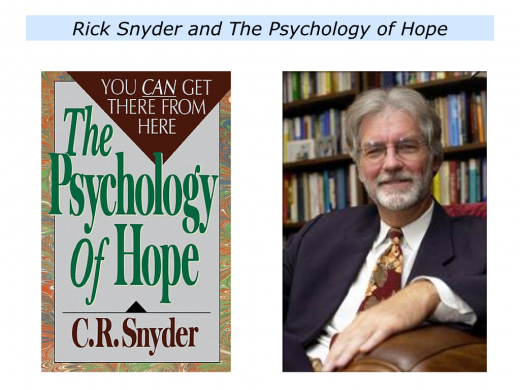
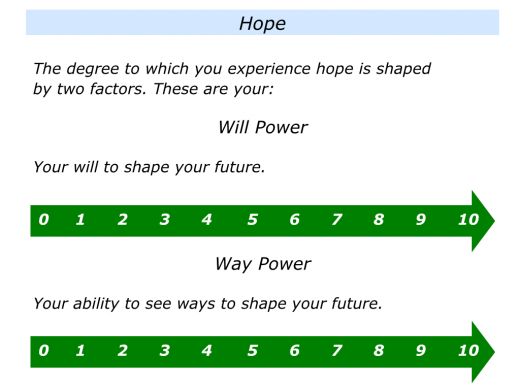
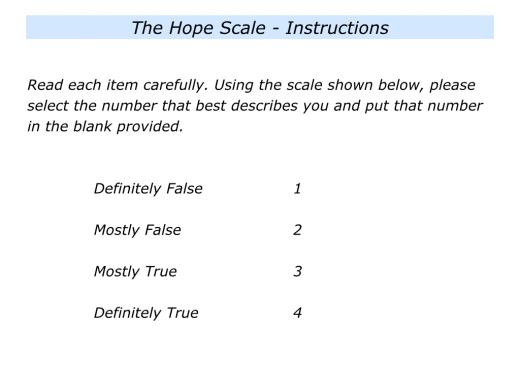
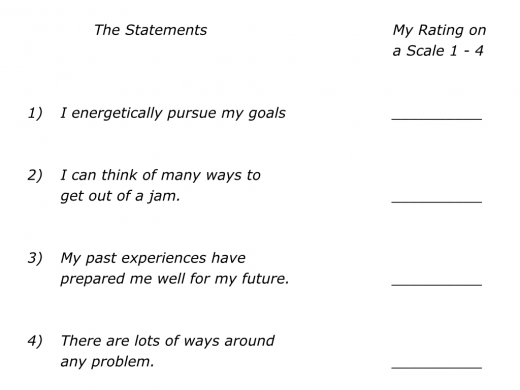
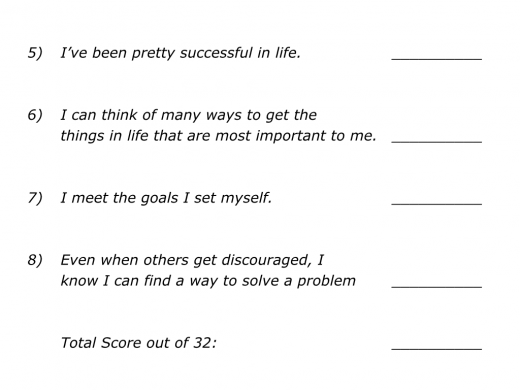
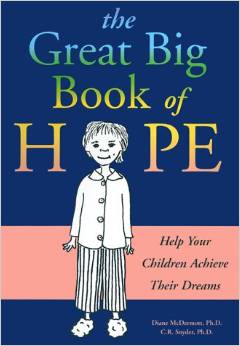
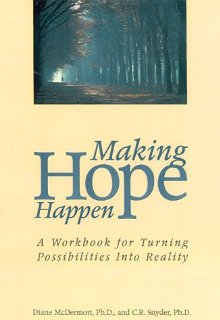
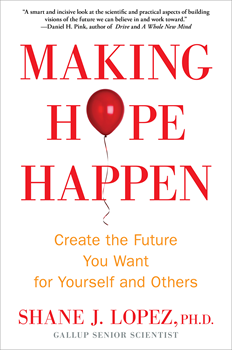




[…] to desired goals and motivate oneself via agency thinking to use those pathway,” according to psychologist C.R. Snyder. In English, perhaps he means that hope is “thinking you can do something.” The […]
Thanks for the work to compile Rick’s contributions into 1 blog, Mike. You wrote in December, and now as we look at hope mid-pandemic, this is a very helpful map to point us where to go to drill deeper. There are so many contexts which result in improvement with the application of hope, and such a need for understanding and viewing life with positive psychology; this will be a helpful link for me. Hope can be learned.
I just discovered this today as we await the nail-biting election results. It is just what I needed on many levels. I never thought of hope in such a dynamic and scientific way.
Amazing…thank you!